Pakistani passport
| Pakistani passport پاکستانی پاسپورٹ | |
|---|---|
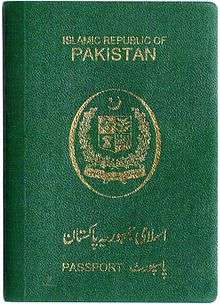 The front cover of a contemporary Pakistani passport. | |
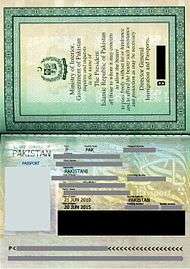 Current Pakistani passport. (Areas containing personal information are grayed out.) | |
| Issued by |
|
| Type of document | Passport |
| Purpose | Identification |
| Eligibility requirements | Pakistani citizenship |
| Expiration | 5 and 10 Years |
| Cost |
₨3000 (US$28) - 5 Years Validity ₨5400 (US$51)- 10 Years Validity |
The Pakistani passport (Urdu: پاکستانی پاسپورٹ) is issued to citizens of Pakistan for the purpose of international travel. The Directorate General of Immigration & Passports of the Ministry of Interior[1] is responsible for issuing passports. Pakistan's machine-readable and biometric passports are currently being issued from regional passport offices and Pakistani embassies. Pakistani passport holders are eligible to visit 33 countries without a visa, or with visa on arrival.
In 2004, Pakistan became one of the first countries in the world to issue the biometric passports, which are, according to the publisher, compliant with ICAO standards and dubbed Multi-biometric e-Passports.[2] They do not carry the "chip inside" symbol (![]()
History
Under British Raj
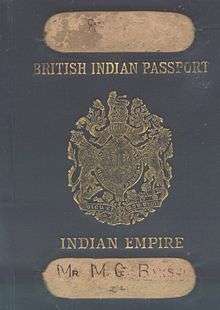
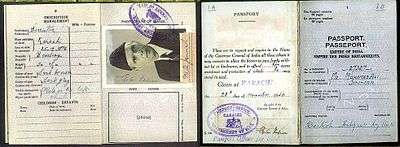
The British Indian passport was issued to the British subjects of British Indian Empire, British subjects from other parts of the British Empire, and the subjects of the British protected states in India (i. e. the British Protected Persons of the 'princely states').[8] The use of passports was introduced to British India after the First World War.[9] The Indian Passport Act of 1920 required the use of passports, established controls on the foreign travel of Indians, foreigners travelling to and within India.[10] The passport was based on the format agreed upon by 1920 League of Nations International Conference on Passports.[11] However, the British Indian passport had very limited usage, being valid for travel only within the British Empire, Italy, Switzerland, Austria, Czechoslovakia, Germany, France, Spain, Norway, Sweden and Holland.[12]
The use of the passport was discontinued after the independence of India and Pakistan in 1947, and its bearers were entitled to opt for Indian, Pakistani or British nationality.Passport regime only started between the two countries from 1952. Citizens of both India and Pakistan did not need a visa or were issued one on arrival till the Second Kashmir War. Before the war, citizens of both countries could freely travel to each other's countries, despite the fact that both had gone to war in 1947 over the princely state of Kashmir.[13]
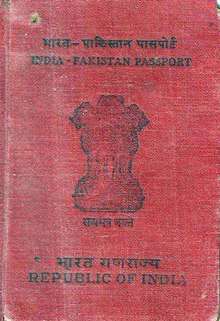
1940s
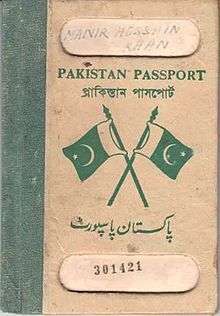
Issued in late 1947, the cover of Pakistan’s first passport was largely beige in colour and only partially green. It had 'Pakistan Passport' written in three languages: English, Bengali, and Urdu. It had two Pakistan flags, one symbolising West Pakistan and the other East Pakistan. Inside, there was the holder's name, address, profession, photo, and marital status. Pakistanis did not require pre-arrival visas and could get visas-on-arrival in any country they wished to travel, including India.[14]
1950s

By 1954, the colour green had ousted the beige. The two flags were still there, but the holder's name now appeared on the cover. Due to tensions between the state and the Bengali majority of East Pakistan, the government had introduced the One Unit scheme, which treated the ethnically diverse West Pakistan as a single province and the Bengali-dominated East Pakistan as the other province. Consequently, West Pakistani passports (like the one in the picture) had 'Pakistan Passport' written only in English and Urdu, whereas East Pakistani passports had the same written in English and Bengali. This was soon changed, but the rest of the contents remained the same: holder's name, photo, address, profession, and marital status. Pakistanis could still get on-arrival-visas in most countries, except Israel, the Soviet Union and Afghanistan – countries that Pakistan had developed strained relations with. However, India and Pakistan were still issuing on-arrival-visas to one another despite the fact that both had gone to war in 1948.[14]
The dark green passport lasted till 1960. In 1956, when the Constituent Assembly authored and passed the country's first constitution, it declared Pakistan an Islamic republic. It was also decided that the term 'Islamic Republic of Pakistan' was to appear on Pakistani passports by 1958. However, this never happened because in 1958, the country's powerful president, Iskander Mirza, and its army chief, Ayub Khan, imposed martial law for the first time in Pakistani history. Mirza suspended the constitution, terming it “the peddling of Islam for political gains.” Within the first 20 days of the coup, Ayub ousted Mirza as well and became president in 1959. He changed the name of the country to the Republic of Pakistan.[14]
1960s
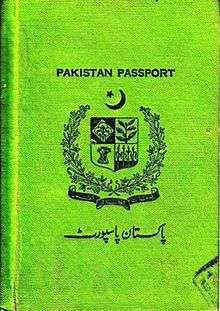
The first passport issued by the Ayub regime was in 1960. It was light green in colour, symbolising the regime's modernist and moderate view of Islam. It just had 'Pakistan Passport' written on it in English and Urdu. The flags were removed and so was the Bengali translation (which had reappeared in the late 1950s). The contents inside remained the same. Pakistanis could receive on-arrival-visas in all countries, except the Soviet Union, communist countries in eastern Europe, and Israel. Afghanistan had begun to give on-arrival visas. The only communist country that gave on-arrival visas to Pakistanis was China. India and Pakistan still had on-arrival-visa policies between them.[14]
In 1967, the colour of the passport was changed back to dark green. The Ayub regime had begun to face harsh criticism from opponents, especially after the 1965 Indo-Pakistani war had ended in stalemate and the once-booming economy had begun to retract. Trouble began to brew on the country's streets and campuses, and Bengali nationalists in East Pakistan became more hostile. The passport turned dark green again and, once more, the words 'Pakistan Passport' began appearing in Bengali. The inside contents remained the same. Pakistanis still enjoyed on-arrival-visa facilities in all the countries, except in communist countries, barring China. However, from 1965 onward, India and Pakistan abolished their long-standing on-arrival-visa policies.[14]
1970s
In 1974, the passport became bluish green in colour and the Bengali text disappeared after Pakistan recognised Bangladesh. This was due to the fact that in December 1971, East Pakistan had seceded to become Bangladesh. When Zulfikar Ali Bhutto's left-leaning and populist Pakistan Peoples Party (PPP) came to power in 1973, it authored and passed the country's third constitution. Even though the new constitution changed the country's name back to Islamic Republic of Pakistan, the new name did not appear on the passport. The contents inside changed a bit though. Apart from having the holder's name, address, profession, and marital status, a section was added to note the colour of the holder's eyes. From 1970 onward, the U.S. ended its policy of giving on-arrival-visas to Pakistanis, but the Soviet Union and communist countries began to relax their visa policies towards Pakistan somewhat. Nevertheless, Pakistanis were still able to enjoy on-arrival-visas in most countries.[14]
In 1974, the passport also came with the disclaimer that Pakistanis could not use the passport to travel to Israel and South Africa, which was under the apartheid regime at the time. In 1979, the passport was more or less the same, but the Urdu words 'Pakistan passport' were shifted on top and the English ones pushed down. In July 1977, a reactionary military coup pulled off by General Zia-ul-Haq had toppled the Bhutto regime, but the name Islamic Republic of Pakistan had yet to appear on the passports. The contents inside remained the same as they were in 1974. However, the revived on-arrival-visa policies between Pakistan and Afghanistan were abolished again, mainly due to the communist revolution in Afghanistan in 1978 and the Soviet invasion of that country in 1979. Barring the communist countries (except for China) and the U.S., Pakistanis could still get on-arrival-visas in most countries.[14]
1980s
In 1984, major changes were made to the Pakistani passport. Zia was still at the helm and had accelerated his Islamization. The country's official name, though changed to Islamic Republic of Pakistan in 1973, only appeared on the passports for the first time in 1984. The word 'Passport', in addition to English and Urdu, also appeared in Arabic. There were two reasons for this. Firstly, more and more Pakistanis were going to oil-rich Gulf countries for work. Secondly, Arab cultural and theological influence had been allowed by the regime to seep inside the country’s institutions. The contents of the new passport inside now had an additional section in which the holder had to declare their faith. Also, they had to sign a declaration that they were not members of the Ahmadiyya community in order to receive the passport. Though the community had been ousted from the fold of Islam by a National Assembly Bill in 1974, a new ordinance in 1984 introduced further restrictions on the community. In 1983, UK and other major European countries stopped providing on-arrival-visas to Pakistanis. Pakistanis could also not get Afghan visas (and vice versa), but the visa policies between India and Pakistan were greatly relaxed. Pakistanis still could not get visas for the Soviet Union and other communist countries easily, but China continued to provide on-arrival-visas. Soon, the Gulf states changed their policies as well and Pakistanis were required to have pre-arrival visas for the UAE, Qatar, Oman, Kuwait, and Saudi Arabia. Libya had already stopped providing on-arrival-visas to Pakistanis in 1980.[14]
1990s–present

In the early 1990s, a few years after the end of the Zia dictatorship, the passport changed again. The green became slightly lighter in colour, and the English words 'Islamic Republic of Pakistan' were once again pushed up and the Urdu ones pushed down. The Arabic text was removed, but the section noting the holder's faith remained and so did the declaration denouncing the Ahmadiyya community. This version of the passport has remained as is till this day, even though the Pervez Musharraf regime (1999-2008) attempted to replace the words 'Islamic Republic of Pakistan' with the old 'Republic of Pakistan'. But the attempt failed due to protests by religious parties. After 9/11, and the rise of religious militancy in Pakistan, more and more countries stopped providing on-arrival-visa facilities to Pakistanis. Pakistanis now require a pre-arrival visa for China as well. According to a 2016 Henley and Partners Visa Restrictions Report, the Pakistani passport's value has been rapidly diminishing in the last two decades and it is now one of the least valuable passports in the world.[14]
As of 2016, Pakistani embassies in some European countries have begun to provide, to dual-nationals only, Pakistani passports that have 'Pakistan' written on them in English and the words 'Islamic Republic of Pakistan' in Urdu only. This cover might gradually be adopted for passports held by all Pakistanis in the future.[14]
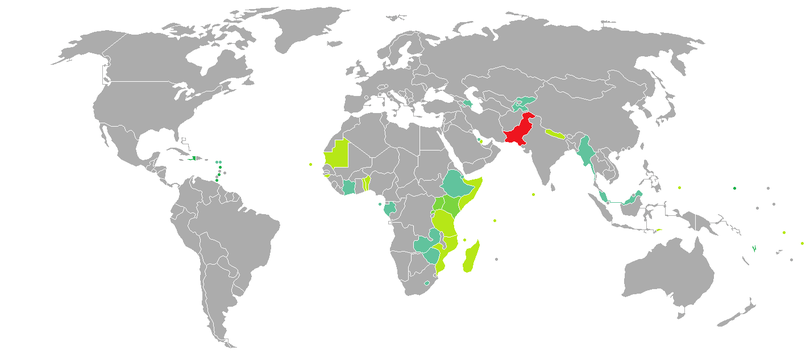
Types
The passports are printed by the governmental agency DGIP. The Passport Act, 1974 and Passport and Visa Manual 1974 regulate the issuance of passports. There are three types of passports being issued in Pakistan:[15]
- Diplomatic Passport
- Official Passport
- Ordinary Passport
Diplomatic passports are issued by the Ministry of Foreign Affairs to diplomats and other entitled categories in pursuance of Para-45 of Passport & Visa Manual, 2006.[16]
Official passports are issued to Senators, Members of the National Assembly, provincial ministers, judges of the supreme/high courts, officers serving with the governments when abroad on official assignments etc.The color outer cover of official passport of Pakistan is blue instead of green. (Para-9 of the Passport & Visa Manual, 2006)
A special Hajj passport was formerly issued to those making a hajj pilgrimage to Mecca, Saudi Arabia. They are however no longer issued, as ordinary passports may be utilised for the Hajj pilgrimage.
Security features
The key features of Pakistan passport are:
- PKI – Public Key Infrastructure
- RFID Chip
- Biometric features namely Facial & Fingerprint
- IPI- Invisible Personal ID
- 2D Bar code
- Machine-Readable Zone (MRZ)
- Security Substrate and Laminate
- Ultra Violet features Micro Printing
- Holograms
- Watermark Paper
- Security Ink
- 3 Colour Intaglio Printing
- Guilloche Patterns
Physical appearance

Pakistani passports have a deep green cover with golden colored content. Emblem of Pakistan is emblazoned in the center of the front cover. The words 'Islamic Republic of Pakistan' (English) are inscribed above the Emblem whereas 'Urdu: اسلامی جمہوریہ پاکستان', 'Urdu: پاسپورٹ' and 'Passport' (English) are inscribed below the emblem. The standard passport contains 36 pages, but frequent travelers can opt for a passport containing 72 or 100 pages.
Passport holder identity
Until 2004, Pakistani passports had the bearers particulars written by hand, with the passport picture glued to the cover page. These older passports looked very unsophisticated and the newer passports have identity information printed on both front and back cover ends. Both of these pages are laminated to prevent modification.
- The opening cover end contains the following information:
- Photo of Passport Holder
- Type 'P'- Stands for "Personal", 'D'- Stands for "Diplomat", - S'- Stands for "Service"
- Country Code
- Passport number
- Surname
- Given Name
- Nationality
- Date of Birth
- Citizenship Number
- Gender
- Place of birth
- Father Name
- Date of issue
- Date of expiry
- Issuing Authority
- Tracking Number
- Booklet Number
- 1st page of regular booklet contains the note from President of Pakistan (mentioned later).
- 2nd page mentions ANNOTATION on the top and contains the following
- Religion
- Previous Passport Number (if any)
- Signature of Passport holder
- 3rd page declares that said passport is valid to travel all countries of the world except ISRAEL.
Passport note
The passports contain a note from the President of Pakistan addressing the authorities of all states, identifying the bearer as a citizen of the Islamic Republic of Pakistan and requesting and requiring that the bearer be allowed to pass freely without any hindrance and be assisted and protected in any need. The note inside of Pakistani passports states:
| “ | Ministry of Interior, Government of Pakistan requires & requests in the name of President of Islamic Republic of Pakistan all those to whom it may concern to allow the bearer to pass freely without let or hindrance and to afford the bearer such assistance and protection as may be necessary.
|
” |
Visa requirements
In 2018, Pakistani citizens had visa-free or visa on arrival access to 33 countries and territories.
See also
References
- ↑ "Directorate General of Immigration & Passports, Ministry of Interior, Government of Pakistan". Retrieved 29 October 2016.
- ↑ Administrator. "Multi-Biometric e-Passport". Retrieved 29 October 2016.
- ↑ ICAO website Machine-Readable travel documents, specifications for electronically enabled MRtds with biometric identification capacity (doc 9303 part 3 vol 2) Archived 2010-11-22 at the Wayback Machine.
- ↑ http://unpan1.un.org/intradoc/groups/public/documents/un-dpadm/unpan048580.pdf
- ↑ Tribune - Biometric passports to be introduced in 2017
- ↑ "Archived copy". Archived from the original on 2013-07-01. Retrieved 2013-07-01.
- ↑ Directorate General of Immigration & Passports Website Archived 2013-01-06 at the Wayback Machine.
- ↑ "Dominions 1931-1947". Historical Atlas of the British Empire. Retrieved 16 December 2015.
- ↑ MumbaiSpace Indian Passport History Archived October 6, 2010, at the Wayback Machine.
- ↑ Passport (Entry into India) Act, 1920 (No. 34 of 1920)
- ↑ History of Passports
- ↑ Vazira Fazila-Yacoobali Zamindar (2007). The Long Partition and the Making of Modern South Asia. Columbia University Press. p. 162. ISBN 0-231-13846-6.
- ↑ https://www.dawn.com/news/1283918
- 1 2 3 4 5 6 7 8 9 10 Paracha, Nadeem F. (15 September 2016). "History of the Pakistani passport". DAWN. Retrieved 15 September 2016.
- ↑ Types of Passport Archived 2009-12-09 at the Wayback Machine.
- ↑ regulated by Para-45 of the Passport & Visa Manual, 2006